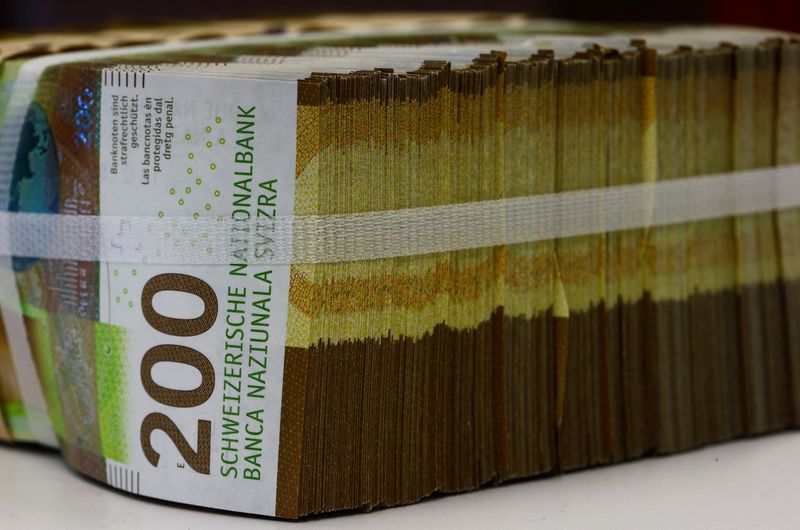By Harry Robertson
LONDON (Reuters) – As investors turn to the Swiss franc as an alternative to the Japanese yen to finance carry trades, the risk that the currency will stage one of its rapid rallies remains ever-present.
The Swiss franc has long been used in the popular strategy where traders borrow currencies with low interest rates and then exchange them for other currencies to buy higher-yielding assets.
Its appeal has increased further as the yen has dimmed. Carry trades in the yen imploded in August after the currency rose sharply following weak US economic data and a surprise rate hike by the Bank of Japan, which helped fuel unrest in global markets.
The Swiss National Bank (SNB) was the first major central bank to initiate an easing cycle earlier this year and its key interest rate is 1.25%, allowing investors to borrow francs cheaply to invest elsewhere.
For comparison, interest rates are between 5.25% and 5.50% in the United States, 5% in Great Britain and 3.75% in the Eurozone.
“The Swiss franc is back as a financing currency,” said Benjamin Dubois, global head of overlay management at Edmond de Rothschild Asset Management Suisse.
STABILITY
The franc is near eight-month highs against the dollar and nine-year highs against the euro. This reflects its status as a safe haven currency and expectations for interest rate cuts in Europe and the US.
But investors are hoping for a gradual decline in the currency’s value, which could increase returns on carry trades.
Speculators have maintained a $3.8 billion short position against the Swiss franc while abruptly switching to a $2 billion long position on the yen, data from the U.S. Commodity Futures Trading Commission shows.
Analysts typically view a large short position as a sign that a currency is being used to finance carry trades.
“There is now more two-way risk in the yen than there has been for quite some time,” said Kamal Sharma, senior G10-FX strategist at Bank of America. “The Swiss franc seems to be the most logical financing currency.”
BofA recommends investors buy British pounds against the franc, arguing the pound could rise due to the large interest rate differential between Switzerland and Britain, in a call from Goldman Sachs.
It appears that the SNB will cut rates further in the coming months as inflation declines. That would lower the cost of borrowing the franc and could weigh on the currency, making it cheaper to pay back those who already borrow the currency.
Central bankers also appear reluctant to see the currency strengthen further, partly because of the pain it could cause exporters. BofA and Goldman Sachs say they believe the SNB intervened to weaken the currency in August.
“The SNB will likely protect itself against currency appreciation through interventions or rate cuts if necessary,” said Michael Cahill, Goldman’s G10 currency strategist.
‘INHERENT RISK’
Yet the , as it is known in the currency markets, can be an unreliable friend.
Investors tend to dip into the currency when they get nervous, thanks to its long-standing reputation as a safe haven.
Cahill said the franc is best used as a financing currency at times when investors are feeling optimistic.
A rapid rally in the currency used to finance carry trades could wipe out gains and cause investors to quickly unwind their positions, as the yen drama showed. High volatility or a decline in the currency with higher interest rates can have the same effect.
The SNB and Swiss regulator Finma declined to comment on questions from Reuters about the impact of carry trades on the Swiss currency.
When stock markets tumbled in early August, the Swiss franc rose as much as 3.5% in two days. The franc-dollar pair has proven sensitive to the U.S. economy, often rallying sharply on weak data that causes U.S. Treasury yields to fall.
“Any carry trade is inherently risky and this is especially true for trades funded with safe-haven currencies,” said Michael Puempel, FX strategist at Deutsche Bank.
“The biggest risk is that when interest rates fall in a risky environment, yield differentials narrow and the Swiss franc could rise,” Puempel added.
A gauge of how much investors expect the Swiss currency to move, derived from option prices, is currently around the highest point since March 2023.

“If you look at central banks, you can see that there may be more sentiment among some carry players to favor the franc over the yen,” said Nathan Vurgest, head of trading at Record Currency Management.
“The ultimate success of this carry trade could still depend on how quickly it can be closed in a risk-off scenario,” Vurgest said, referring to a time when investors halted their riskier trades to focus on protecting of their money.


